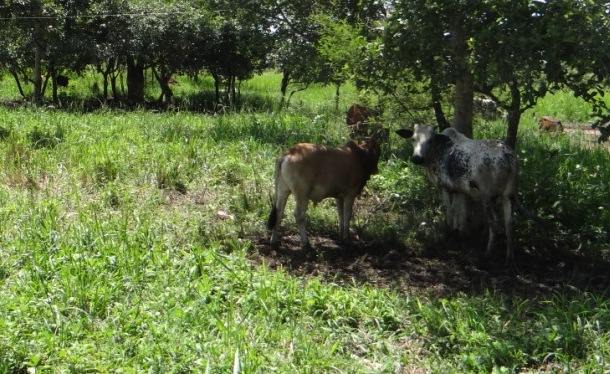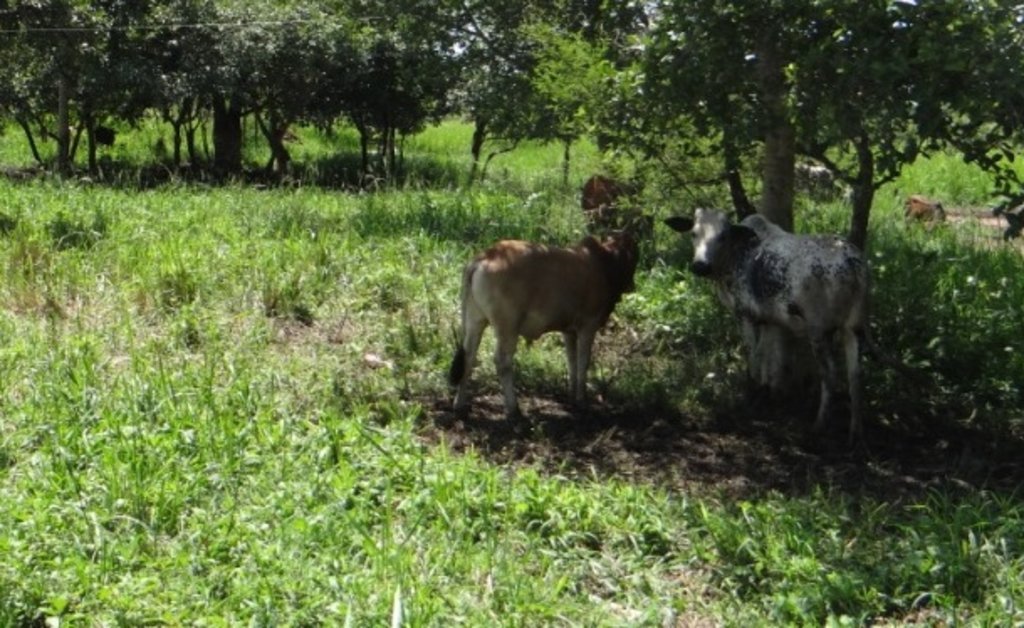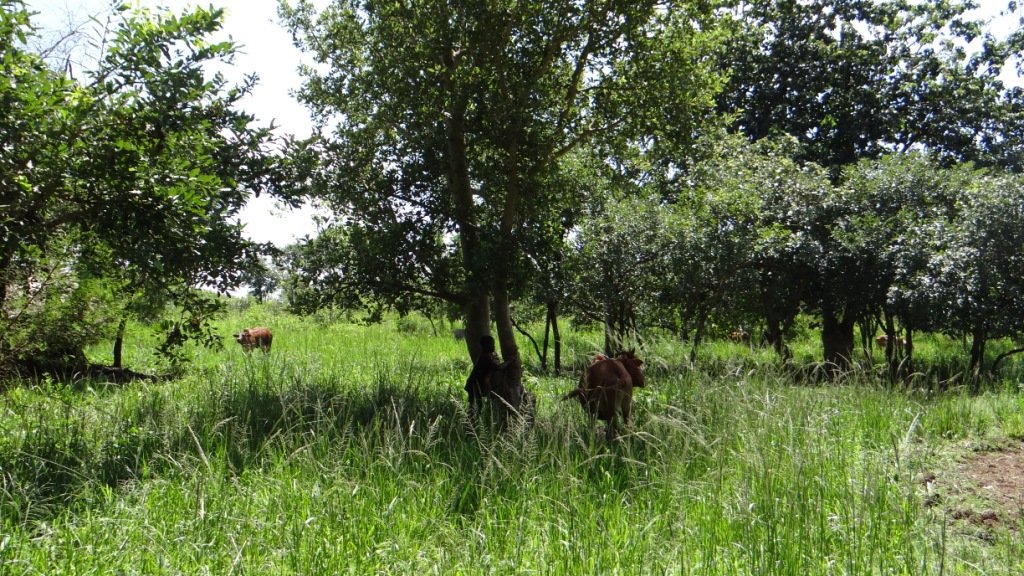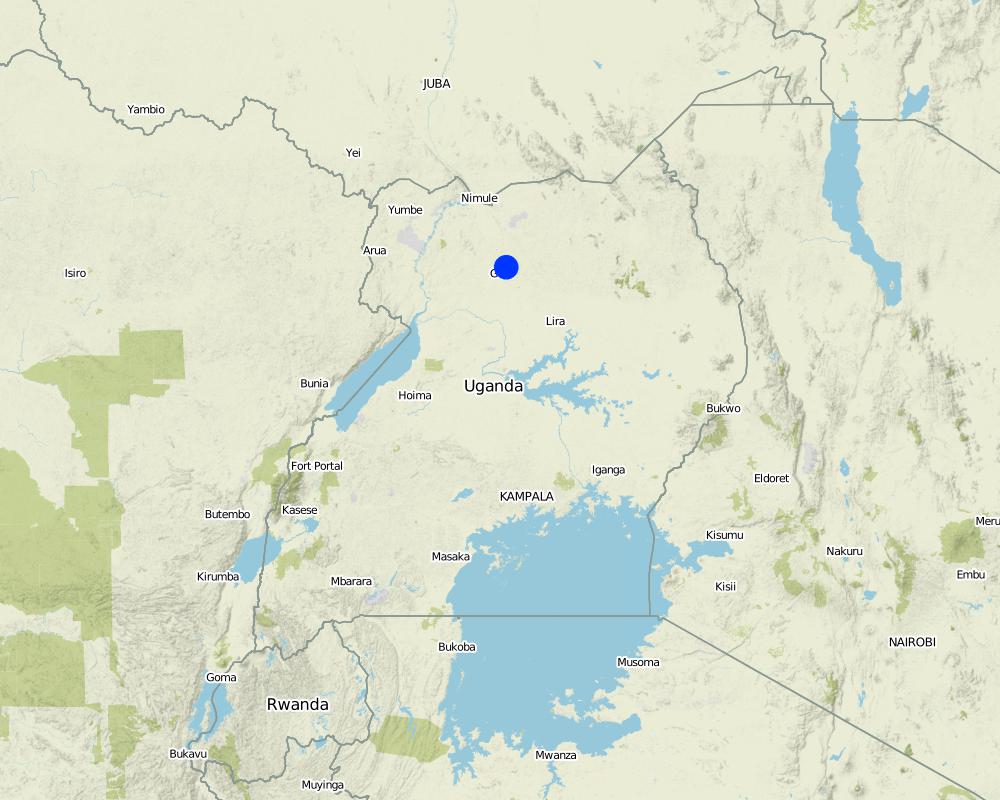Controlled livestock grazing for soil fertility improvement [Uganda]
- Creation:
- Update:
- Compiler: Kamugisha Rick Nelson
- Editors: JOY TUKAHIRWA, Richard Otto Kawawa, Bernard Fungo
- Reviewers: Donia Mühlematter, John Stephen Tenywa, Nicole Harari, Renate Fleiner, Rima Mekdaschi Studer, Alexandra Gavilano
technologies_2761 - Uganda
- Full summary as PDF
- Full summary as PDF for print
- Full summary in the browser
- Full summary (unformatted)
- Controlled livestock grazing for soil fertility improvement: 22 مايو، 2018 (inactive)
- Controlled livestock grazing for soil fertility improvement: 16 يوليو، 2018 (inactive)
- Controlled livestock grazing for soil fertility improvement: 22 مارس، 2019 (inactive)
- Controlled livestock grazing for soil fertility improvement: 11 أغسطس، 2019 (public)
View sections
Expand all Collapse all1. معلومات عامة
1.2 Contact details of resource persons and institutions involved in the assessment and documentation of the Technology
Key resource person(s)
land user:
Ojok Robinson
Gulu District
Uganda
Name of project which facilitated the documentation/ evaluation of the Technology (if relevant)
Scaling-up SLM practices by smallholder farmers (IFAD)Name of the institution(s) which facilitated the documentation/ evaluation of the Technology (if relevant)
Uganda Landcare Network (ULN) - Uganda1.3 Conditions regarding the use of data documented through WOCAT
The compiler and key resource person(s) accept the conditions regarding the use of data documented through WOCAT:
نعم
1.4 Declaration on sustainability of the described Technology
Is the Technology described here problematic with regard to land degradation, so that it cannot be declared a sustainable land management technology?
لا
2. Description of the SLM Technology
2.1 Short description of the Technology
Definition of the Technology:
Integrated crop-livestock production for improved soil fertility management. Local cows are tied to trees to facilitate manure collection.
2.2 Detailed description of the Technology
Description:
Controlled livestock grazing is a common practice promoted by farmers in Northern Uganda, who own up to 4-6 cows raised on two or more acres of land. Although the primary purpose is to produce milk for domestic consumption and for sale, the other subsidiary aim is to generate manure to replenish soil fertility on continuously cultivated and nutrient depleted land and pasture that the cows graze on. During the rainy season crops are planted and animals fed by cut and carry or pegged/ tied with a radius of 2-5 meters. During dry season the animals can graze on crop residues
For this technology, cattle are tethered/ tied on a pole (pegged) or tree using a sisal rope. Tethering distance should allow each cow to access pasture uninterrupted by others. The animals are rotated/ relocated routinely to minimise overgrazing in a given location. The manure produced is collected daily, and kept in heaps to compost for periods of 2 to 3 weeks, before being ferried to the fields for application for the cultivation of maize and other crops like soya bean . This technology requires possession of sufficient land for grazing the animals, as well as sufficient labour for handling manure through composting up to field application. The key inputs required for establishing this technology include labour, hand hoes, spades, sisal ropes, basins, sacks and basket for collecting manure and its transportation to the maize field, watering containers , spraying pumps for spraying animals against ticks and feeds to supplement the grazing during shortage of pasture.
The benefits derived from such a technology are both short and long term, including access to increased manure to apply on crop fields especially maize for increased production
To replicate this technology, the land user needs to have knowledge and skills on how to manage the animals to generate high quality manure, compost it and maintain it free of contamination with pesticides sprayed on the animals against pests and diseases, which may affect the quality of the manure and the safety of the users.
2.3 Photos of the Technology
2.4 Videos of the Technology
Comments, short description:
Video showing Controlled grazing for soil fertility improvement in Gulu District, Northern Uganda.
Date:
26/05/2017
الموقع:
Gulu District, Northern Uganda
Name of videographer:
Issa Aiga
2.5 Country/ region/ locations where the Technology has been applied and which are covered by this assessment
بلد:
Uganda
Region/ State/ Province:
Northern Region
Further specification of location:
Gulu Municipality, Gulu District
Specify the spread of the Technology:
- evenly spread over an area
If precise area is not known, indicate approximate area covered:
- < 0.1 km2 (10 ha)
Comments:
Map showing Controlled livestock grazing technology site in Gulu District, Northern Uganda.
Map
×2.6 Date of implementation
Indicate year of implementation:
2012
If precise year is not known, indicate approximate date:
- less than 10 years ago (recently)
2.7 Introduction of the Technology
Specify how the Technology was introduced:
- through land users' innovation
- through projects/ external interventions
Comments (type of project, etc.):
Started on his own with only 2 cows and later National Agricultural Advisory Services (NAADS) and Operation Wealth Creation (OWC) supported him with training on management (rotating, feeding and animal manure application in the garden).
3. Classification of the SLM Technology
3.1 Main purpose(s) of the Technology
- improve production
- reduce, prevent, restore land degradation
- create beneficial economic impact
3.2 Current land use type(s) where the Technology is applied

أراضي الرعي
Intensive grazing/ fodder production:
- Cut-and-carry/ zero grazing
Animal type:
- cattle - dairy
Species:
cattle - dairy
Count:
5
3.4 Water supply
Water supply for the land on which the Technology is applied:
- rainfed
Comments:
Normally two rain seasons March to May and September to December
3.5 SLM group to which the Technology belongs
- integrated crop-livestock management
- integrated soil fertility management
3.6 SLM measures comprising the Technology

agronomic measures
- A2: Organic matter/ soil fertility
Comments:
Manure collected is used on maize crop to increase maize production.
3.7 Main types of land degradation addressed by the Technology

chemical soil deterioration
- Cn: fertility decline and reduced organic matter content (not caused by erosion)

biological degradation
- Bc: reduction of vegetation cover
3.8 Prevention, reduction, or restoration of land degradation
Specify the goal of the Technology with regard to land degradation:
- prevent land degradation
- reduce land degradation
Comments:
Decomposed manure when applied on the maize field increases production.
4. Technical specifications, implementation activities, inputs, and costs
4.1 Technical drawing of the Technology
Author:
Kaheru
Date:
24/05/2017
4.2 General information regarding the calculation of inputs and costs
Specify how costs and inputs were calculated:
- per Technology unit
Specify unit:
0.5 acres
Specify dimensions of unit (if relevant):
pegged/ tied with a radius of 2-5 meters
other/ national currency (specify):
UGX
If relevant, indicate exchange rate from USD to local currency (e.g. 1 USD = 79.9 Brazilian Real): 1 USD =:
3445,0
Indicate average wage cost of hired labour per day:
5000
4.3 Establishment activities
| Activity | Timing (season) | |
|---|---|---|
| 1. | Buy local cows/ varieties for keeping | Once before stocking / dry season |
| 2. | Look for inputs , labour, sack, basins and ropes | Before stocking |
| 3. | Tie the cows on a tree using a sisal rope | During establishment |
| 4. | Plant the crop to provide crop residues | During the wet season |
4.4 Costs and inputs needed for establishment
| Specify input | Unit | Quantity | Costs per Unit | Total costs per input | % of costs borne by land users | |
|---|---|---|---|---|---|---|
| Labour | Planting | persons | 2,0 | 150000,0 | 300000,0 | 100,0 |
| Labour | Tieing, feeding and grazing cows | persons | 2,0 | 150000,0 | 300000,0 | 100,0 |
| Equipment | Hoe | pieces | 1,0 | 10000,0 | 10000,0 | 1000,0 |
| Equipment | Spade | peices | 1,0 | 10000,0 | 10000,0 | 1000,0 |
| Equipment | Spraying pump | pieces | 1,0 | 250000,0 | 250000,0 | 100,0 |
| Equipment | Watering trays | pieces | 6,0 | 100000,0 | 600000,0 | 100,0 |
| Plant material | Maize seed | Kgs | 10,0 | 2500,0 | 25000,0 | 100,0 |
| Other | Local cows | cow | 6,0 | 700000,0 | 4200000,0 | |
| Other | Buckets | pieces | 1,0 | 3500,0 | 3500,0 | 100,0 |
| Other | Sack | pieces | 2,0 | 1000,0 | 2000,0 | 100,0 |
| Other | Feeds | Kgs | 100,0 | 4000,0 | 400000,0 | 100,0 |
| Other | Crop residues (not bought) | |||||
| Total costs for establishment of the Technology | 6100500,0 | |||||
| Total costs for establishment of the Technology in USD | 1770,83 | |||||
Comments:
Money used is got from sale of milk and also obtained a loan of 2,000,000 from a savings group.
4.5 Maintenance/ recurrent activities
| Activity | Timing/ frequency | |
|---|---|---|
| 1. | Watering the cow | Daily during the dry season |
| 2. | Tieing and feeding the cow | Daily |
| 3. | Spraying the cows against ticks | Weekly |
| 4. | Heaping and carrying manure to the garden | Everyday/ after 2 weeks |
| 5. | Applying manure in the soil | Before planting season |
| 6. | Relocating the cows | Every after 2 days |
| 7. | Cutting and carrying pasture | After harvest |
4.6 Costs and inputs needed for maintenance/ recurrent activities (per year)
| Specify input | Unit | Quantity | Costs per Unit | Total costs per input | % of costs borne by land users | |
|---|---|---|---|---|---|---|
| Labour | Labour paid on monthly basis | Persons | 2,0 | 150000,0 | 300000,0 | 100,0 |
| Equipment | Replacement worn our equipment | pieces | 3,0 | 20000,0 | 60000,0 | 100,0 |
| Fertilizers and biocides | Pestcide | litres | 10,0 | 15000,0 | 150000,0 | 100,0 |
| Total costs for maintenance of the Technology | 510000,0 | |||||
| Total costs for maintenance of the Technology in USD | 148,04 | |||||
Comments:
The land use employs 2 people on monthly basis watering, tieing , feeding, spraying, relocating carrying manure and cutting and carrying pasture. No equipment bought in short run since most of the equipment is bought at establishment. Only if there is need for replacement.
4.7 Most important factors affecting the costs
Describe the most determinate factors affecting the costs:
Labour takes the most costs since the tasks re routine compared to the cost of equipment which is bought and replaced after its worn out.
5. Natural and human environment
5.1 Climate
Annual rainfall
- < 250 mm
- 251-500 mm
- 501-750 mm
- 751-1,000 mm
- 1,001-1,500 mm
- 1,501-2,000 mm
- 2,001-3,000 mm
- 3,001-4,000 mm
- > 4,000 mm
Specify average annual rainfall (if known), in mm:
1350,00
Agro-climatic zone
- humid
5.2 Topography
Slopes on average:
- flat (0-2%)
- gentle (3-5%)
- moderate (6-10%)
- rolling (11-15%)
- hilly (16-30%)
- steep (31-60%)
- very steep (>60%)
Landforms:
- plateau/plains
- ridges
- mountain slopes
- hill slopes
- footslopes
- valley floors
Altitudinal zone:
- 0-100 m a.s.l.
- 101-500 m a.s.l.
- 501-1,000 m a.s.l.
- 1,001-1,500 m a.s.l.
- 1,501-2,000 m a.s.l.
- 2,001-2,500 m a.s.l.
- 2,501-3,000 m a.s.l.
- 3,001-4,000 m a.s.l.
- > 4,000 m a.s.l.
Indicate if the Technology is specifically applied in:
- concave situations
5.3 Soils
Soil depth on average:
- very shallow (0-20 cm)
- shallow (21-50 cm)
- moderately deep (51-80 cm)
- deep (81-120 cm)
- very deep (> 120 cm)
Soil texture (topsoil):
- medium (loamy, silty)
Soil texture (> 20 cm below surface):
- medium (loamy, silty)
Topsoil organic matter:
- medium (1-3%)
5.4 Water availability and quality
Ground water table:
< 5 m
Availability of surface water:
medium
Water quality (untreated):
good drinking water
Is water salinity a problem?
نعم
حددها:
Presence of borehole
Is flooding of the area occurring?
لا
Comments and further specifications on water quality and quantity:
The bore hole is seasonal - shortage of water during the dry season.
5.5 Biodiversity
Species diversity:
- medium
Habitat diversity:
- medium
5.6 Characteristics of land users applying the Technology
Sedentary or nomadic:
- Sedentary
Market orientation of production system:
- mixed (subsistence/ commercial)
Off-farm income:
- less than 10% of all income
Relative level of wealth:
- average
Individuals or groups:
- individual/ household
Level of mechanization:
- manual work
- animal traction
Gender:
- women
- men
Age of land users:
- youth
- middle-aged
Indicate other relevant characteristics of the land users:
The land user plans to buy exotic cows for zero grazing to provide more animal manure and milk for sale
5.7 Average area of land used by land users applying the Technology
- < 0.5 ha
- 0.5-1 ha
- 1-2 ha
- 2-5 ha
- 5-15 ha
- 15-50 ha
- 50-100 ha
- 100-500 ha
- 500-1,000 ha
- 1,000-10,000 ha
- > 10,000 ha
Is this considered small-, medium- or large-scale (referring to local context)?
- small-scale
Comments:
Very unproductive land but the farmer slowly improving it with manure from the kept cows.
5.8 Land ownership, land use rights, and water use rights
Land ownership:
- individual, not titled
Land use rights:
- individual
Water use rights:
- communal (organized)
5.9 Access to services and infrastructure
health:
- poor
- moderate
- good
education:
- poor
- moderate
- good
technical assistance:
- poor
- moderate
- good
employment (e.g. off-farm):
- poor
- moderate
- good
markets:
- poor
- moderate
- good
energy:
- poor
- moderate
- good
roads and transport:
- poor
- moderate
- good
drinking water and sanitation:
- poor
- moderate
- good
financial services:
- poor
- moderate
- good
6. Impacts and concluding statements
6.1 On-site impacts the Technology has shown
Socio-economic impacts
Production
animal production
Comments/ specify:
Milk production and the farmer has also increased the number of cows.
land management
Comments/ specify:
Application of locally obtained manure.
Income and costs
expenses on agricultural inputs
Comments/ specify:
More money spent on buying pesticides, basins, buckets, and maize seed.
farm income
Comments/ specify:
From sale of maize and milk.
workload
Comments/ specify:
More activities during establishment.
Socio-cultural impacts
food security/ self-sufficiency
Comments/ specify:
Availability of Maize after harvest for sale and household income.
SLM/ land degradation knowledge
Comments/ specify:
Training on manure application in the maize field.
Ecological impacts
Soil
soil cover
Comments/ specify:
Use of manure and maize stalks.
soil loss
Comments/ specify:
Application of manure and decomposition of maize stalks.
6.2 Off-site impacts the Technology has shown
damage on neighbours' fields
Comments/ specify:
Restricted movements of the cows
6.3 Exposure and sensitivity of the Technology to gradual climate change and climate-related extremes/ disasters (as perceived by land users)
Gradual climate change
Gradual climate change
| Season | increase or decrease | How does the Technology cope with it? | |
|---|---|---|---|
| annual temperature | increase | moderately | |
| seasonal temperature | dry season | increase | moderately |
Climate-related extremes (disasters)
Biological disasters
| How does the Technology cope with it? | |
|---|---|
| epidemic diseases | well |
6.4 Cost-benefit analysis
How do the benefits compare with the establishment costs (from land users’ perspective)?
Short-term returns:
slightly positive
Long-term returns:
very positive
How do the benefits compare with the maintenance/ recurrent costs (from land users' perspective)?
Short-term returns:
slightly positive
Long-term returns:
positive
Comments:
More benefits after establishments.
High costs during establishment.
6.5 Adoption of the Technology
- 1-10%
Of all those who have adopted the Technology, how many did so spontaneously, i.e. without receiving any material incentives/ payments?
- 0-10%
6.6 التكيف
Has the Technology been modified recently to adapt to changing conditions?
لا
6.7 Strengths/ advantages/ opportunities of the Technology
| Strengths/ advantages/ opportunities in the land user’s view |
|---|
| Yield potential is high with good feeding of the cows , right spacing and manure application in maize garden. |
| The technology can easily be replicated by small scale and large scale land users to other areas. |
| Uses sisal ropes which are cheap. |
| Strengths/ advantages/ opportunities in the compiler’s or other key resource person’s view |
|---|
| Minimizes conflicts when cows are tied in one area. |
| Good at providing income and manure for soil fertility improvement. |
6.8 Weaknesses/ disadvantages/ risks of the Technology and ways of overcoming them
| Weaknesses/ disadvantages/ risks in the land user’s view | How can they be overcome? |
|---|---|
| Requires constant labour. | Use family labour to supplement hired labour. |
| Requires technical knowledge on management, spacing and treatment. | Seek technical advice from the extension worker. |
| Weaknesses/ disadvantages/ risks in the compiler’s or other key resource person’s view | How can they be overcome? |
|---|---|
| Easily affected by pests and diseases. | Apply pesticides / seek technical advice from the extension worker. |
7. References and links
7.1 Methods/ sources of information
- field visits, field surveys
01
- interviews with land users
01
When were the data compiled (in the field)?
24/05/2017
Links and modules
Expand all Collapse allLinks
No links
Modules
No modules





